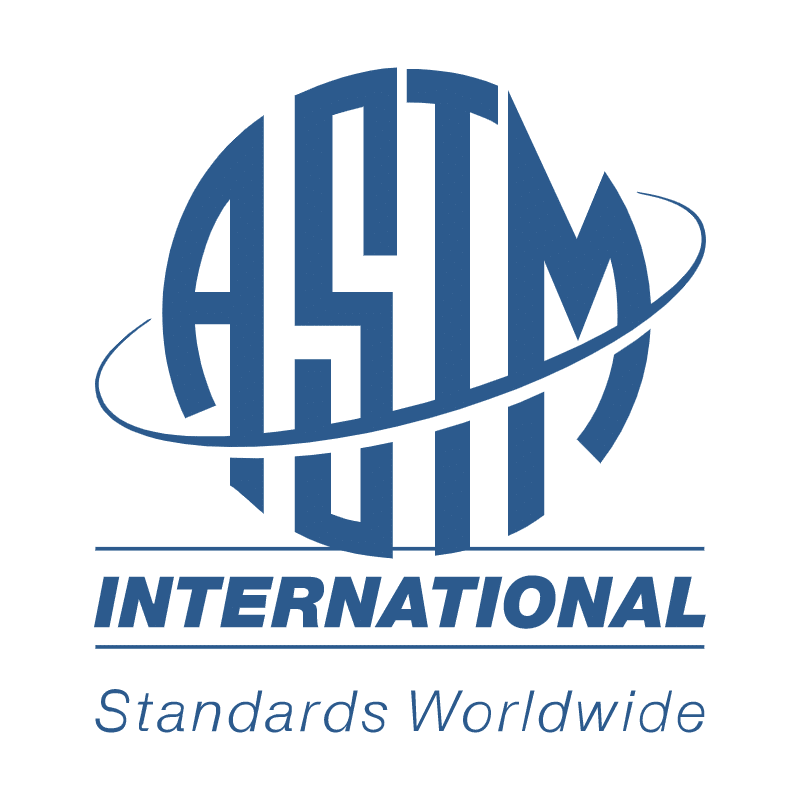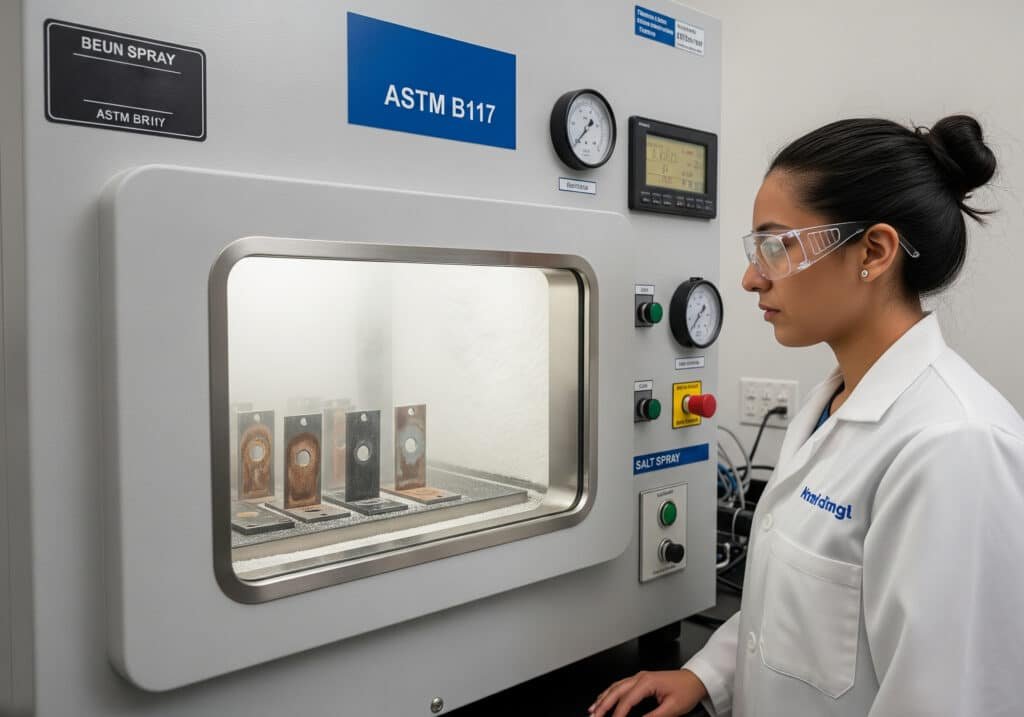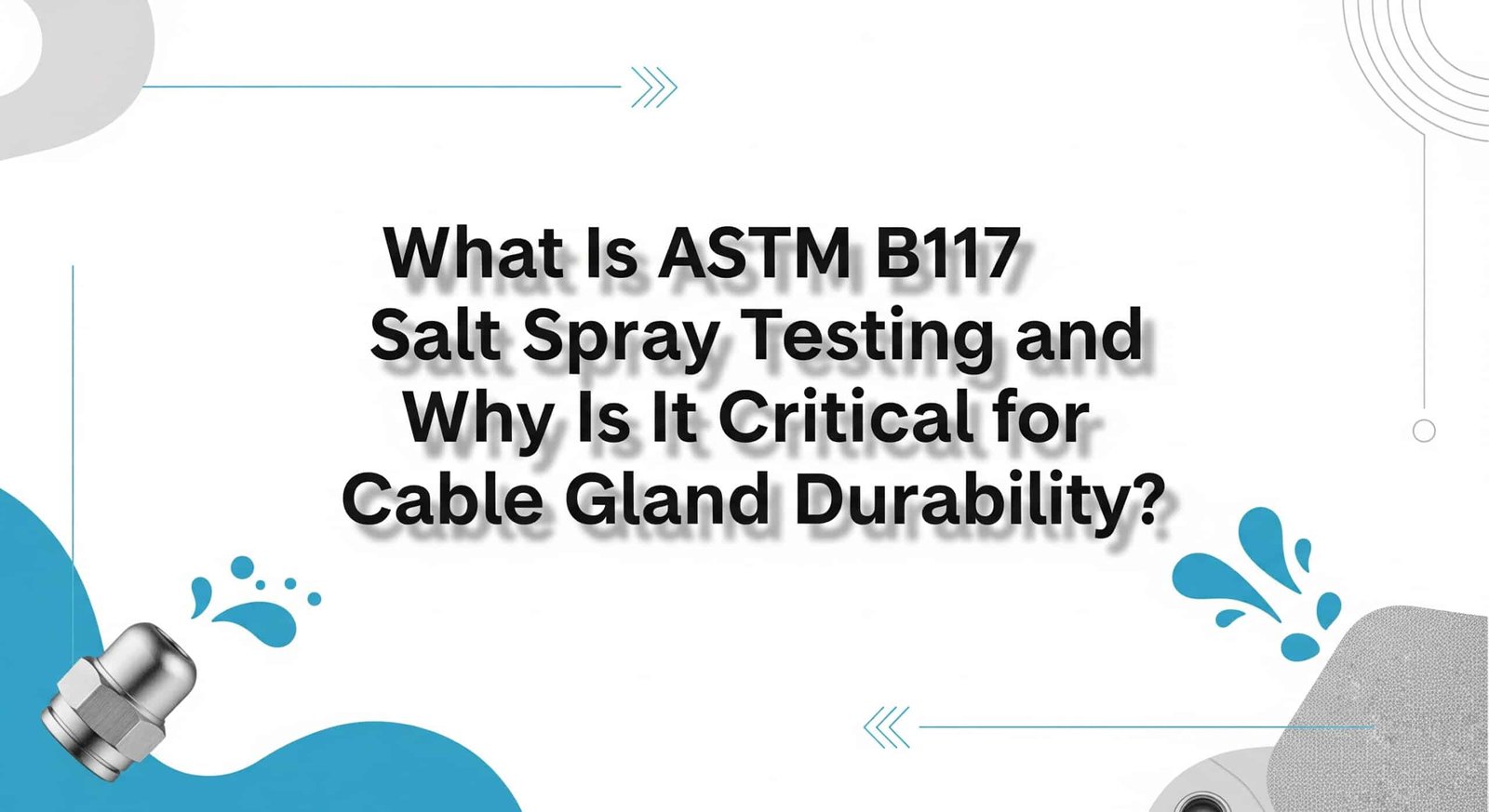Last month, I received an urgent call from Marcus, a project manager at a wind farm installation company in Denmark. “Chuck, we’re seeing severe corrosion on our cable glands after just 18 months in our coastal environment. The supplier claimed they were marine-grade, but they’re failing catastrophically. What went wrong?”
ASTM1 B117 salt spray testing is the gold standard for evaluating corrosion resistance2 of metallic coatings and materials, providing accelerated3 exposure to salt-laden environments that simulate years of real-world coastal conditions in just days or weeks. This test method is absolutely critical for determining whether your cable glands can survive harsh marine, industrial, or coastal applications.
Having witnessed too many costly failures from inadequately tested products, I’ve learned that ASTM B117 compliance isn’t optional for serious applications – it’s the difference between reliable long-term performance and expensive premature failures that can shut down entire operations.
Table of Contents
- What Exactly Is ASTM B117 Salt Spray Testing?
- Why Is ASTM B117 Testing Essential for Cable Gland Selection?
- How Does ASTM B117 Testing Work in Practice?
- What Do ASTM B117 Test Results Mean for Your Applications?
- How to Interpret and Verify ASTM B117 Compliance?
- FAQs About ASTM B117 Salt Spray Testing
What Exactly Is ASTM B117 Salt Spray Testing?
When customers ask me about corrosion resistance, I always start with the fundamentals of accelerated testing.
ASTM B117 is the American Society for Testing and Materials standard that defines the procedure for neutral salt spray (fog) testing to evaluate the corrosion resistance of metallic coatings and materials. Developed in 1939 and continuously refined, this test method creates a highly controlled corrosive environment that accelerates the natural corrosion process.

The Science Behind Salt Spray Testing
The test creates an aggressive corrosive environment using:
- 5% sodium chloride solution (equivalent to seawater salinity)
- Continuous salt fog exposure at 35°C (95°F)
- Controlled humidity near 100% relative humidity
- Precise pH control between 6.5-7.2
- Standardized exposure duration based on application requirements
This controlled environment accelerates corrosion processes that would normally take years in real-world conditions, compressing them into days or weeks of testing.
Key Testing Parameters
ASTM B117 specifies exact conditions that must be maintained:
| Parameter | Specification | Tolerance |
|---|---|---|
| Temperature | 35°C (95°F) | ±2°C |
| Salt Solution | 5% NaCl | ±0.1% |
| pH Level | 6.5-7.2 | ±0.2 |
| Spray Rate | 1-2 mL/80cm²/hour | Measured |
| Air Pressure | 70-175 kPa | Controlled |
At Bepto, our stainless steel and brass cable glands undergo rigorous ASTM B117 testing at accredited laboratories. We’ve found that maintaining these precise conditions is crucial – even small deviations can significantly affect test results and their correlation to real-world performance.
Why Is ASTM B117 Testing Essential for Cable Gland Selection?
Let me share another experience that highlights why this testing matters. Sarah, an electrical contractor working on offshore oil platforms in the North Sea, learned this lesson the expensive way.
“Chuck, we installed 500 cable glands on our platform last year. After just 8 months, we’re seeing rust bleeding through the coating on nearly 30% of them. The replacement cost alone is $50,000, not counting the downtime and safety risks,” she explained during our emergency consultation.
ASTM B117 testing provides quantifiable data on how long your cable glands will resist corrosion in harsh environments, helping prevent costly failures and safety incidents. Here’s why this testing is non-negotiable for critical applications:
Real-World Application Correlation
Different exposure durations correlate to various real-world environments:
96-Hour Testing (Standard)
- Light industrial environments
- Indoor applications with occasional moisture
- General commercial installations
240-Hour Testing (Enhanced)
- Moderate marine environments
- Industrial facilities with chemical exposure
- Coastal installations within 1km of seawater
500+ Hour Testing (Severe Service)
- Direct marine exposure
- Offshore platforms and vessels
- Chemical processing facilities
- Desalination plants
Material Performance Validation
ASTM B117 testing reveals critical performance differences:
Coating Integrity
- Adhesion strength under corrosive attack
- Barrier protection effectiveness
- Coating thickness adequacy
Base Material Quality
Design Vulnerabilities
- Crevice corrosion susceptibility
- Thread protection adequacy
- Seal interface durability
Our experience at Bepto shows that cable glands passing extended ASTM B117 testing (500+ hours) typically provide 5-10 times longer service life in marine environments compared to products with minimal or no salt spray testing.
How Does ASTM B117 Testing Work in Practice?
Understanding the actual testing process helps you appreciate why proper ASTM B117 compliance requires significant investment and expertise.
ASTM B117 testing involves exposing test specimens to continuous salt fog in specialized chambers under precisely controlled conditions, with periodic evaluation for corrosion onset and progression. The process requires sophisticated equipment and trained technicians to ensure accurate, repeatable results.

Testing Chamber Requirements
Proper ASTM B117 testing demands specialized equipment:
Chamber Construction
- Corrosion-resistant materials (typically plastic or glass)
- Uniform temperature distribution
- Adequate ventilation and condensate management
- Precise spray nozzle positioning
Solution Preparation
- Distilled or deionized water base
- Reagent-grade sodium chloride
- pH adjustment with hydrochloric acid or sodium hydroxide
- Regular solution replacement and monitoring
Specimen Preparation
- Standardized cleaning procedures
- Proper mounting and positioning
- Edge protection where specified
- Documentation and identification
Evaluation Methodology
ASTM B117 doesn’t just measure time to first corrosion – it provides comprehensive performance data:
Visual Assessment
- Red rust appearance and coverage percentage
- White corrosion products (zinc-based coatings)
- Coating blistering or delamination
- Base material exposure
Quantitative Measurements
- Corrosion creep from scribes or defects
- Coating adhesion retention
- Color change evaluation
- Surface roughness changes
At Bepto, we conduct ASTM B117 testing on every new cable gland design and coating system. Our stainless steel 316L cable glands consistently exceed 1000 hours without red rust, while our enhanced nickel-plated brass glands achieve 500+ hours – performance levels that translate to decades of reliable service in most applications.
What Do ASTM B117 Test Results Mean for Your Applications?
Interpreting salt spray test results requires understanding both the numbers and their practical implications for your specific operating environment.
ASTM B117 test duration before corrosion onset provides a relative ranking of corrosion resistance, but real-world performance depends on actual environmental conditions, maintenance practices, and application-specific factors. Here’s how to translate test results into practical decisions:
Performance Correlation Guidelines
Test Duration vs. Real-World Expectation
| ASTM B117 Hours | Typical Service Life | Suitable Applications |
|---|---|---|
| 96-240 hours | 2-5 years | Indoor, light industrial |
| 240-500 hours | 5-10 years | Moderate marine, coastal |
| 500-1000 hours | 10-20 years | Direct marine exposure |
| 1000+ hours | 20+ years | Severe marine, offshore |
Important Note: These correlations are approximate and can vary significantly based on actual environmental conditions, maintenance, and installation quality.
Environmental Factor Considerations
Real-world performance depends on multiple factors beyond salt spray resistance:
Temperature Cycling
- Thermal expansion/contraction stress
- Coating flexibility requirements
- Seal material compatibility
UV Exposure
- Polymer degradation acceleration
- Coating color stability
- Surface preparation importance
Chemical Compatibility
- Industrial solvent exposure
- Cleaning agent effects
- Process chemical interactions
Mechanical Stress
- Vibration and shock loading
- Installation torque effects
- Cable movement accommodation
A recent project with Hassan’s petrochemical facility in Kuwait perfectly illustrates this complexity. Despite using cable glands with excellent ASTM B117 performance (750+ hours), we experienced premature failures due to high-temperature cycling and chemical exposure that weren’t adequately considered in the initial selection.
How to Interpret and Verify ASTM B117 Compliance?
This is where many procurement teams make critical mistakes – accepting inadequate documentation or misunderstanding test results.
Proper ASTM B117 verification requires examining detailed test reports from accredited laboratories, understanding test conditions and evaluation criteria, and confirming the tested samples represent your actual product specifications. Here’s your comprehensive verification guide:
Essential Documentation Elements
Complete Test Report Requirements
- Laboratory accreditation credentials (ISO/IEC 170255)
- Detailed test specimen description and preparation
- Exact test conditions and duration
- Photographic documentation of results
- Quantitative evaluation data
- Authorized signatures and dates
Specimen Traceability
- Product identification and lot numbers
- Manufacturing date and batch information
- Coating specifications and thickness
- Material certifications and analysis
Test Condition Verification
- Temperature and humidity logs
- Solution concentration records
- pH monitoring data
- Chamber calibration certificates
Red Flags in ASTM B117 Claims
Watch for these warning signs of inadequate or fraudulent testing:
Documentation Issues
- Generic certificates without specific product details
- Missing laboratory contact information
- Vague test condition descriptions
- Suspiciously perfect results (no variation)
Technical Inconsistencies
- Claims exceeding material capabilities
- Inconsistent coating specifications
- Missing evaluation photographs
- Unrealistic performance claims
Commercial Red Flags
- Pricing significantly below market rates
- Reluctance to provide detailed reports
- Generic product descriptions
- Missing traceability information
At Bepto, we provide complete ASTM B117 documentation packages including original laboratory reports, specimen photographs, and direct laboratory contact information for verification. We encourage customers to independently verify our test results – transparency builds confidence and long-term partnerships.
Practical Verification Steps
Contact the Testing Laboratory
- Verify report authenticity
- Confirm test specimen details
- Review testing procedures used
Cross-Reference Product Specifications
- Match tested samples to your purchase specifications
- Verify coating types and thicknesses
- Confirm material grades and treatments
Request Witness Testing
- Arrange to observe testing procedures
- Verify chamber conditions and calibration
- Document specimen preparation methods
Conclusion
ASTM B117 salt spray testing isn’t just another certification checkbox – it’s your primary tool for predicting long-term corrosion performance and avoiding costly failures in harsh environments. Whether you’re Marcus dealing with coastal wind farms or Sarah managing offshore platforms, understanding and verifying ASTM B117 compliance protects your operations and investment.
The correlation between salt spray performance and real-world durability has been proven across decades of field experience. At Bepto, we’ve built our reputation on providing cable glands with verified ASTM B117 performance that translates to reliable service life in the most challenging environments.
Don’t let corrosion failures compromise your operations. Demand proper ASTM B117 testing documentation and choose suppliers who invest in comprehensive corrosion resistance validation. Your future self will thank you when your installations continue performing years after inferior products have failed. 😉
FAQs About ASTM B117 Salt Spray Testing
Q: How long should cable glands last in ASTM B117 salt spray testing?
A: Cable gland ASTM B117 performance varies by material and coating – stainless steel 316L typically exceeds 1000 hours, nickel-plated brass achieves 240-500 hours, and standard zinc-plated steel reaches 96-240 hours. The required duration depends on your specific application environment and expected service life.
Q: Is ASTM B117 testing the same as real-world marine exposure?
A: No, ASTM B117 provides accelerated corrosion testing under controlled laboratory conditions that correlates to but doesn’t exactly replicate real-world marine exposure. Actual performance depends on temperature cycling, UV exposure, mechanical stress, and maintenance practices not captured in salt spray testing alone.
Q: Can cable glands pass ASTM B117 testing but still fail in service?
A: Yes, cable glands can pass salt spray testing but fail due to other factors like improper installation, mechanical damage, chemical incompatibility, or extreme temperature cycling. ASTM B117 tests only corrosion resistance, not overall durability under all operating conditions.
Q: How much does ASTM B117 testing cost for cable gland manufacturers?
A: ASTM B117 testing typically costs $500-2000 per test series depending on specimen quantity, test duration, and laboratory location. Extended testing (500+ hours) and detailed evaluation increase costs, which is why many low-cost suppliers skip comprehensive salt spray validation.
Q: What’s the difference between ASTM B117 and other salt spray standards?
A: ASTM B117 uses neutral salt spray (5% NaCl), while other standards like ASTM B368 use copper-accelerated testing and ISO 9227 includes additional test variations. ASTM B117 remains the most widely recognized standard for general corrosion resistance evaluation of cable glands and electrical components.
-
Learn more about the organization that develops and publishes technical standards for materials, products, systems, and services ↩
-
Understand the fundamental concept of how materials resist degradation from chemical reactions with their environment ↩
-
Discover how laboratory testing methods compress years of real-world exposure into shorter timeframes for faster evaluation ↩
-
Learn about the electrochemical process that occurs when dissimilar metals are in contact in the presence of an electrolyte ↩
-
Explore the international standard that specifies requirements for testing and calibration laboratory competence ↩




